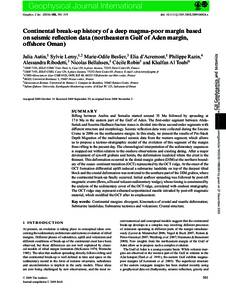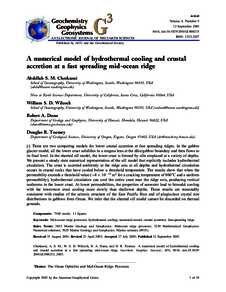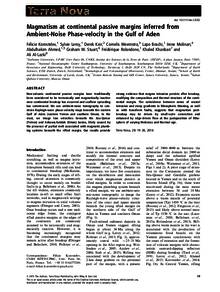Document
Continental break-up history of a deep magma-poor margin based on seismic reflection data (northeastern Gulf of Aden margin, offshore Oman).
Identifier
DOI: 10.1111/j.1365-246X.2009.04424.x
Contributors
Leroy, Sylvie., Author
Beslier, Marie-Odile., Author
d'Acremont, Elia., Author
Razin, Philippe., Author
Ribodetti, Alessandra., Author
Bellahsen, Nicolas., Author
Robin, Cecile., Author
Al-Toubi, Khalfan., Author
Publisher
Oxford University Press.
Gregorian
2010-02
Language
English
English abstract
Rifting between Arabia and Somalia started around 35 Ma followed by spreading at 17.6 Ma in the eastern part of the Gulf of Aden. The first-order segment between Alula-Fartak and Socotra-Hadbeen fracture zones is divided into three second-order segments with different structure and morphology. Seismic reflection data were collected during the Encens Cruise in 2006 on the northeastern margin. In this study, we present the results of Pre-Stack Depth Migration of the multichannel seismic data from the western segment, which allows us to propose a tectono-stratigraphic model of the evolution of this segment of the margin from rifting to the present day. The chronological interpretation of the sedimentary sequences is mapped out within relation to the onshore observations and existing dating. After a major development of syn-rift grabens and horsts, the deformation localized where the crust is the thinnest. This deformation occurred in the distal margin graben (DIM) at the northern boundary of the ocean-continent transition (OCT) represented by the OCT ridge. At the onset of the OCT formation differential uplift induced a submarine landslide on top of the deepest tilted block and the crustal deformation was restricted to the southern part of the DIM graben, where the continental break-up finally occurred. Initial seafloor spreading was followed by post-rift magmatic events (flows, sills and volcano-sedimentary wedge), whose timing is constrained by the analysis of the sedimentary cover of the OCT ridge, correlated with onshore stratigraphy. The OCT ridge may represent exhumed serpentinized mantle intruded by post-rift magmatic material, which modified the OCT after its emplacement.
Member of
ISSN
0956-540X
Resource URL
Category
Journal articles



